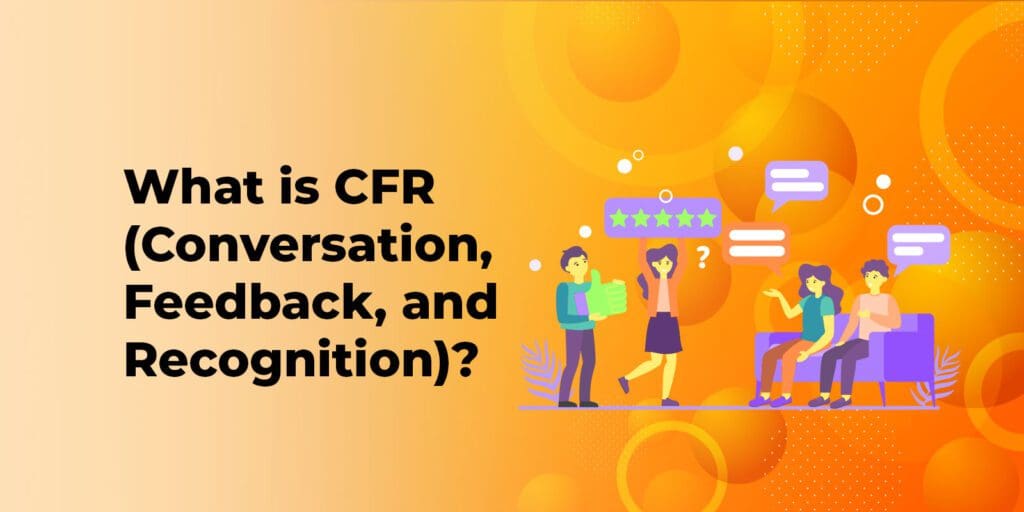Table of Contents
CFR: The Trifecta for Workplace Success
Conversations, Feedback, and Recognition are referred to as CFR. The CFRs belief is that, timely feedback and acknowledgement, and regular dialogues between managers and employees are crucial for employee development.
Conversation, Feedback, and Recognition (CFR) are the result of public, transparent OKRs. They help keep employees in the loop and allow for flexibility to adapt according to changing expectations and circumstances regarding the goals set by the OKR framework. In this blog, let’s take a look at how the CFR model works and what its benefits are.
A Brief Insight into CFRs
CFRs maintain performance reviews and provide both feedback and appreciation/recognition for the employees. It creates a company culture of continuous improvement, engagement, and recognition in the workplace. According to the book Measure What Matters by John Doerr, the definition of the three main components are as follows:
- Conversations: These are “authentic, richly textured exchanges between manager and contributor, aimed at driving performance.”
- Feedback: This is “bidirectional or networked communication among peers to evaluate progress and guide future improvement.”
- Recognition: Recognition is the set of “expressions of appreciation to deserving individuals for contributions of all sizes.”
Here are a few questions to ask for Conversation and Feedback:
- How effective have the OKRs been so far?
- Does our team have enough critical capabilities needed to succeed?
- What are the potential obstacles we will face?
- How to adjust the OKRs to shift our priorities? What do we add, and what do we cancel?
Continuous Feedback and its Benefits
Continuous feedback is periodical feedback that should ideally be like clockwork because of its regularity and adherence to a continuous schedule. In this feedback mechanism, new ideas are brought up and reviews are given along with an examination of existing issues. It gives employees the chance to rectify their mistakes and grow with the organisation.
It is important to note that feedbacks work both ways: the employer gives the employee constructive criticism and vice versa. Both teams should be open-minded to receive feedback in such a way that every person in the originations feels like they have an active role to play. It is also crucial to ask for feedback based on your performance on a particular project instead of waiting for the feedback session. This will aid in personal growth and make the employee receptive to both positive and negative feedback.


Continuous Recognition and its Benefits
As a powerful engagement tool, continuous recognition will boost employee morale and drive performance. Employees can implement a good recognition system by encouraging peer-to-peer recognition amongst team members or establishing clear titles like “Employee of the Month.”
Employees are the heart of a company, and once they feel heard and seen, they will contribute more towards company success and align their focus towards the OKRs in place. Recognition must be frequent and achievable so that the employees do not get dejected quickly. Recognition can be given for any commendable work like cost-cutting, customer service, innovation, and so on.
What are the Benefits of CFR?
Smoother Conversation: The usage of the Conversation, Recognition, and feedback (CFR) management process encourages smoother usage of dialogues and discussions amongst employees to produce actionable feedback. It helps manage and improve performance by reviewing the goals during these regular feedback conversations. Moreover, these conversations include goal-setting reflection and ongoing progress updates as well.
Improved Feedback: Since the feedback given is specific and constructive, it will help both the employees and employers communicate coherently. It should be aimed at genuinely helping a colleague who has the potential for growth. Hence, only relevant feedback should be given.
Removal of Barriers During Reviews: During regular performance review sessions it is quite formal and orderly. However, here, the managers/leaders don’t have to worry about the element of scrutiny since the conversations are casual and regular enough to be mundane. Team members also feel closer to their leaders when working together.
CFR Encourages Timely Recognition: Regular performance reviews are assigned between longer intervals. Due to this, employee recognition is delayed, and they might start feeling disheartened. However, continuous recognition enables timely appreciation of hard work. CFR recognises people who feel motivated enough to keep pushing to get more awards/ appreciation on time.
Creation of a healthy and stable relationship between managers and employees: The casual conversations between employees and managers, recognition of hard work and constructive criticism all stem from the CFR approach. Moreover, feedback works both ways as employees also give their opinion on how things could potentially improve within the company culture. There is a space of mutual learning without hierarchical boundaries.
How to Combine OKRs and CFRs for Optimal Performance Management?
OKRs (Objectives and Key Results) are an important framework for goal setting and tracking measurable results. The Objectives are very significant and action-driven. Key results are quantifiable and specific. When combined with CFRs, companies can boost employee morale and drive performance. Together, they form Continuous Performance Management (CPM). While OKRs can be graded in terms of just ‘complete’ or ‘incomplete,’ CFRs offer a wider vocabulary range.
CFRs happen throughout the OKR cycle during 1:1 meetings. They should also happen, especially at the end of the OKR cycle. Together, they help employees achieve quick wins within the given time frame of the Key Results in the OKR framework. While OKRs outline the objectives and how to achieve them, CFRs motivate the employees in their OKR journey by providing feedback and recognition. CFRs act as the fuel that keeps the OKR machine working by going beyond the mere question of “Was the goal achieved or not?”
Are you confused about how to get started on your OKR journey? Are you overwhelmed with the information available online?
Ready to unlock the power of CFR and take your organisation to new heights?
Sign up for free today on 10xOKR’s website and connect with our experts to get your OKR-related queries resolved.
Start your journey towards achieving exceptional results with OKR!
FAQs
How can I promote effective conversations within my team or organization?
To promote effective conversations, create a safe and inclusive environment where individuals feel comfortable expressing their thoughts and ideas. Encourage active listening, empathy, and respectful dialogue.
What are the benefits of implementing CFR practices in terms of employee engagement and productivity?
By fostering open conversations, employees feel valued, heard, and included, resulting in higher job satisfaction and commitment. Constructive feedback helps in increasing productivity and efficiency.
Are there any tools or technologies that can support CFR initiatives?
OKR and CFR are interdependent drivers of organizational success. Together, they align teams, foster open conversations, and drive performance towards achieving objectives.



